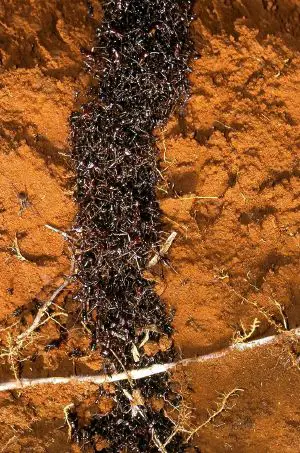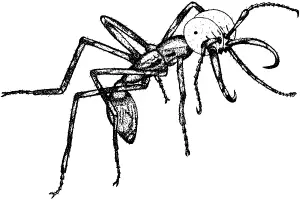Army ant
The name army ant (or legionary ant) is applied to over 200 known species, in different lineages, together characterized primarily by their aggressive predatory foraging groups, known as "raids", in which huge numbers of ants all forage simultaneously over a certain area, attacking prey en masse. They also share the habit of not constructing a permanent nest, unlike most ants, and an army ant colony moves almost incessantly over the time it exists. All species are members of the true ant family Formicidae, but there are several groups that have independently evolved the same basic behavioral and ecological syndrome. This syndrome is often referred to as "legionary behavior", and is an example of convergent evolution.
Usage, circumscription
Historically, "army ant" referred, in the broad sense, to various members of 5 different ant subfamilies: in two of these cases, the Ponerinae and Myrmicinae, it is only a few species and genera that exhibit legionary behavior; in the other three lineages, Ecitoninae, Dorylinae, and Leptanillinae, all of the constituent species are legionary. More recently, ant classifications now recognize an additional New World subfamily, Leptanilloidinae, which also consists of obligate legionary species, and thus is another group now included among the army ants.
A 2003 study of thirty species (by Sean Brady of Cornell University) indicates that the ecitonine and doryline army ants together formed a monophyletic group: all shared identical genetic markers that suggest a common ancestor. Brady concluded that these two groups are therefore a single lineage that evolved in the mid-Cretaceous period in Gondwana[1], and so the two subfamilies are now generally united into a single subfamily Ecitoninae, though this is still not universally recognized (e.g. [2]).
Accordingly, the army ants as presently recognized consist of the following genera:
Subfamily Ponerinae:
- Leptogenys (some species)
- Onychomyrmex
- Simopelta
Subfamily Myrmicinae:
- Pheidolegeton
Subfamily Leptanilloidinae:
- Asphinctanilloides
- Leptanilloides
Subfamily Leptanillinae:
- Anomalomyrma
- Leptanilla
- Phaulomyrma
- Protanilla
- Yavnella
Subfamily Ecitoninae:
- Aenictus
- Cheliomyrmex
- Dorylus
- Eciton
- Labidus
- Neivamyrmex
- Nomamyrmex
Ecitoninae
| Ecitoninae | ||||||||||||||||||
|---|---|---|---|---|---|---|---|---|---|---|---|---|---|---|---|---|---|---|
| Scientific classification | ||||||||||||||||||
| ||||||||||||||||||
|
Cheliomyrmecini |
Most New World army ants belong to the subfamily Ecitoninae. This subfamily is further broken into two groups in the New World, the tribes Cheliomyrmecini and Ecitonini. The former contains only the genus Cheliomyrmex, and the tribe Ecitonini contains four genera, Neivamyrmex, Nomamyrmex, Labidus, and Eciton, the genus after which the group is named (Brady, 2003, Tree of Life). The genus Neivamyrmex is the largest of all army ant genera, containing some 120 species, all in the United States. The most predominant species of Eciton is Eciton burchellii, whose common name is "army ant" and which is considered to be the archetypal species.
The Old World army ants are divided between the two tribes Aenictini and Dorylini (often treated as Dorylini alone), each of which is made up of a single genus; in the former case, Aenictus, that contains over 100 species of army ant, while the Dorylini contains the aggressive "driver ants" in the genus Dorylus, of which there are some 70 species known.
Army ant taxonomy remains ever-changing, and genetic analysis will continue to provide more information about the relatedness of the various species; many genera contain large numbers of taxa at the rank of subspecies (e.g., Dorylus, in which some 60 of roughly 130 named taxa are only considered subspecies at present).
New World Army Ants
There are about 150 species of army ants in the New World (that is, North, South, and Central America), all in the tribe Ecitonini. Although these army ant species are found from Kansas to Argentina, few people in North America realize that there are plenty of army ants living in the United States, in part because the colonies are rarely very abundant, and because the United States species (mostly genus Neivamyrmex) are quite small (~5 mm), with small and generally unobtrusive raiding columns, most often active at night, and easily overlooked.
Eciton burchellii and Eciton hamatum are the most visible and best studied of the New World army ants because they forage above ground and during the day, in enormous raiding swarms. Their range stretches from southern Mexico to the northern part of South America.
Old World Army Ants
There are over 100 species of army ants in the Old World, all in the tribe Dorylini (in some older classifications, also the tribe Aenictini), approximately equal numbers in the genera Aenictus and Dorylus. The latter group is by far the better-known, including the infamous "driver ants" (or "safari ants").
External links
Explore the New World Army Ant phylogeny:
References and further reading
- O'Donnell, S., Kasparim M., and Lattke, J. Extraordinary Predation by the Neotropical Army Ant Cheliomyrmex andicola: Implications for the Evolution of the Army Ant Syndrome. Biotropica 37: 706[1]
- Wilson, Edward O, and Bert Hölldobler, (1990) The Ants (Pulitzer Prize)
Notes
- ↑ BBC News, Dr. David Whitehouse, "Ant history revealed" 10 May 2003.
- ↑ Engel, M.S., Grimaldi, D.A. 2005. Primitive new ants in Cretaceous amber from Myanmar, New Jersey, and Canada (Hymenoptera: Formicidae). American Museum Novitates 3485: 1–24.
External links
Personal website on research and computer modeling of army ants (with video and images):
References and further reading
- Brady, S. (2003). Evolution of the army ant syndrome: the origin and long-term evolutionary stasis of a complex of behavioral and reproductive adaptations.. PNAS 100(11): 6575-6579.
- Gotwald, W.H., Jr. (1995). Army ants: the biology of social predation. Ithaca, New York: Cornell University Press. ISBN 0-8014-9932-1.
- Rice, Nathan H., and A. M. Hutson (2003). "Antbirds and Army-Ant Swarms", in Christopher Perrins (Ed.): Firefly Encyclopedia of Birds. Firefly Books, 449. ISBN 1-55297-777-3.
- Wilson, Edward O, and Bert Hölldobler, (1990) The Ants (Pulitzer Prize),
Credits
New World Encyclopedia writers and editors rewrote and completed the Wikipedia article in accordance with New World Encyclopedia standards. This article abides by terms of the Creative Commons CC-by-sa 3.0 License (CC-by-sa), which may be used and disseminated with proper attribution. Credit is due under the terms of this license that can reference both the New World Encyclopedia contributors and the selfless volunteer contributors of the Wikimedia Foundation. To cite this article click here for a list of acceptable citing formats.The history of earlier contributions by wikipedians is accessible to researchers here:
The history of this article since it was imported to New World Encyclopedia:
Note: Some restrictions may apply to use of individual images which are separately licensed.

